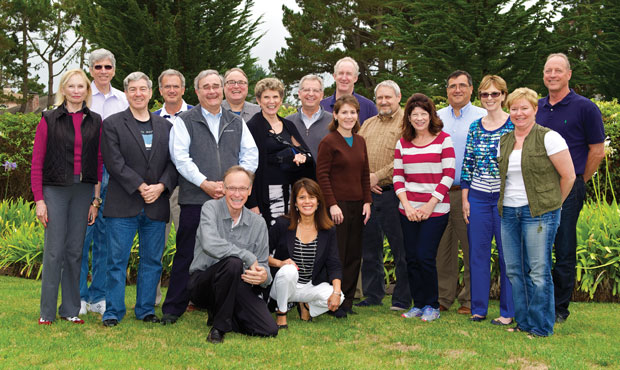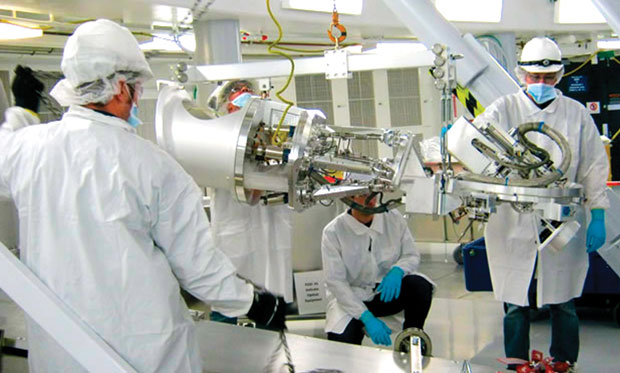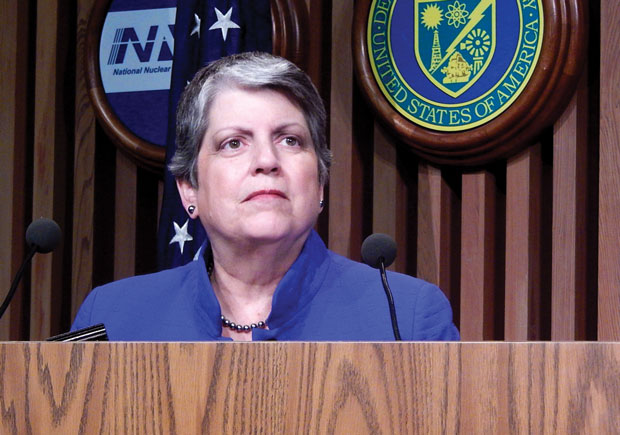Excellence in management, business, and operations and attention to the needs of the workforce complement LLNL’s outstanding performance in science and technology. FY 2014 was a year of management changes and steps to build for future successes.
Bill Goldstein Named Director
On March 27, 2014, William H. Goldstein was named as the Laboratory’s director and the president of Lawrence Livermore National Security, LLC (LLNS), which manages the Laboratory for DOE. Goldstein replaces Parney Albright, who stepped down as director on October 31, 2013. Bret Knapp, who returned to Livermore from a key management position at Los Alamos, adroitly led LLNL as acting director through a critical period following the federal budget sequestration at the beginning of the fiscal year (see Bret E. Knapp).
Goldstein’s “passion for the Lab’s mission and people” was cited by Norman J. Pattiz, chairman of the LLNS Board of Governors, as he announced the selection. Goldstein has a distinguished 29-year career at the Laboratory as a physicist and scientific leader with extensive management experience. Prior to being named director, he served as the deputy director for science and technology.
Management Changes and Expanding Partnerships
Director Goldstein and his senior management team, which included many new faces in FY 2014 (see photo below), reaffirmed the Laboratory’s role of providing the nation “Science and Technology on a Mission” and developed a strategic vision for moving forward. An important thrust of LLNL senior management is reaching out to expand partnerships with work sponsors, research collaborators, and stakeholders. A top priority is effective communications and strengthened relationships with DOE and NNSA Headquarters, congressional and executive-branch leaders, and the Laboratory’s many work sponsors. Within NNSA/DOE, the Laboratory is actively participating—and providing leadership—in many headquarters–contractor initiatives to devise solutions to complex-wide issues.
In addition, LLNL is teaming with other DOE entities in large initiatives such as the CORAL supercomputer partnership (see Nuclear Deterrence) and the DOE Office of Science Accelerated Climate Modeling for Energy (ACME) project. A newly created Strategic Development Office will assist in Laboratory-wide program development activities and in selecting areas of opportunity that engage other federal agency work sponsors. We are also reaching out to academia and U.S. industry through broad initiatives, many of which are tied to the Livermore Valley Open Campus.
Investments in People and Facilities
The Laboratory provides a wide range of employee development, mentoring, and leadership training programs to ensure the continuing quality of its outstanding staff. Senior management’s focus is on an active employee recognition program, workforce reviews and succession planning, strong efforts in recruiting, and attention to work–life balance programs and work environment quality serve to meet the needs of a talented, inclusive, and diverse workforce.
Top-notch scientists and engineers are attracted to LLNL by the opportunity to conduct cutting-edge, mission-focused research at world-class facilities. In FY 2014, the Laboratory updated its science and technology investment strategy, which guides institutional investments in exploratory research, capabilities to meet emerging national needs, and LLNL’s foundational science and technology base. Investments enabled existing facilities to meet NNSA goals for reliable operation and allowable levels of deferred maintenance. In addition, construction is scheduled to start on three new facilities at LLNL.
Quality Operations
In FY 2014, operations at the Laboratory were effectively and efficiently managed in all principal areas, including business operations and systems; human resources; legal management; facilities and infrastructure; and safety, security, and sustainability (see Safety, Security, and Sustainability). Supply Chain Management and Asset Management at LLNL and the Laboratory’s Financial Office earned the highest ratings possible in assessments, and the Financial Office received the highest rating awarded by the DOE Office of Field Financial Management. In addition to institution-wide continuous improvement efforts, 28 Six Sigma process-improvement projects were completed with projected savings of more than $12 million, and Management Assurance System performance analysis tools identified ways to improve operational activities in several areas.
Strong Research Partnerships
In a visit to LLNL, University of California (UC) President Janet Napolitano pledged to expand university collaboration with the Laboratory. Nearly 25 percent of our published papers are co-authored by UC colleagues, and LLNL is engaged in a growing number of frontier research projects with UC, ranging from President Barack Obama’s BRAIN Initiative to work on “big data.” Partnerships are also expanding with many other outstanding research institutions, including Texas A&M University, Georgetown University, the New York University Center for Urban Science and Progress, and Rand Corporation. Efforts to partner with industry are exemplified by LLNL’s leadership in establishing the California Network for Manufacturing Innovation.
LLNS Board of Governors Activities
The LLNS Board of Governors and its committees provided oversight in critical areas related to mission and mission-support activities. The committees delved into their specific areas and members participated in Functional Management Reviews (FMRs) and external review committees (ERCs). In FY 2014, LLNS held seven FMRs in selected topic areas such as performance metrics, work planning and control, the Laboratory’s asset management system, the ombuds program, and the Chronic Beryllium Disease Prevention Program. In addition, about a dozen mission/science ERC reviews were conducted. The LLNS Board also approved the Contract Assurance System Annual Assurance Letter, including revisions to ensure that the performance reporting system promotes sustained, responsive engagement with LLNL senior management and the NNSA Livermore Field Office.









